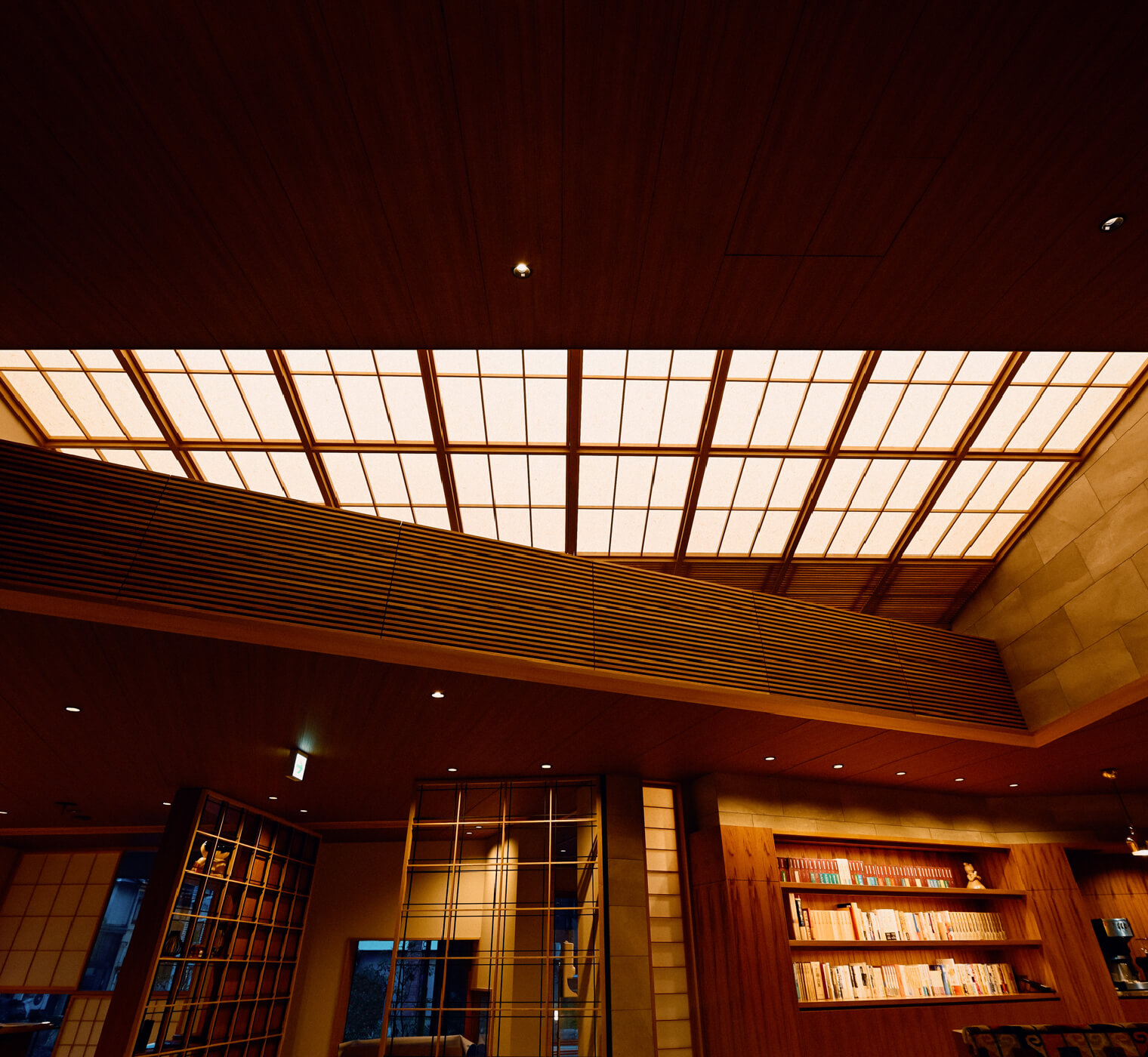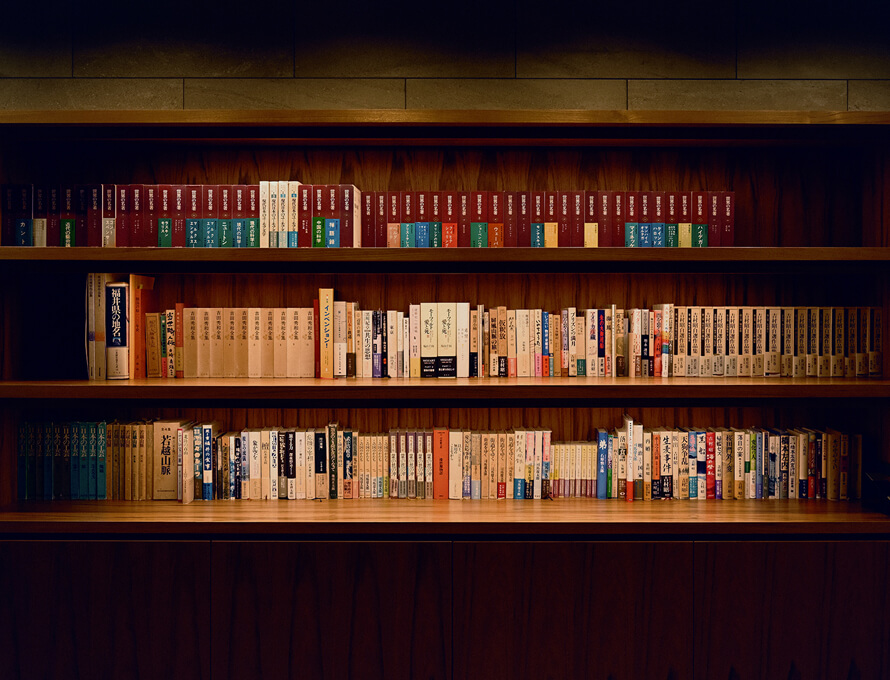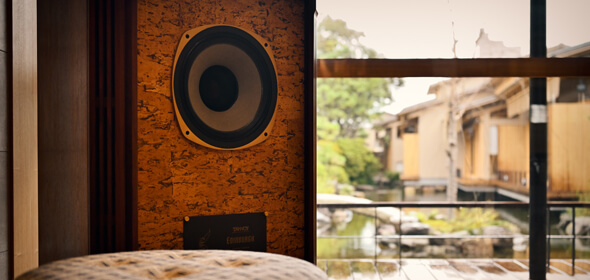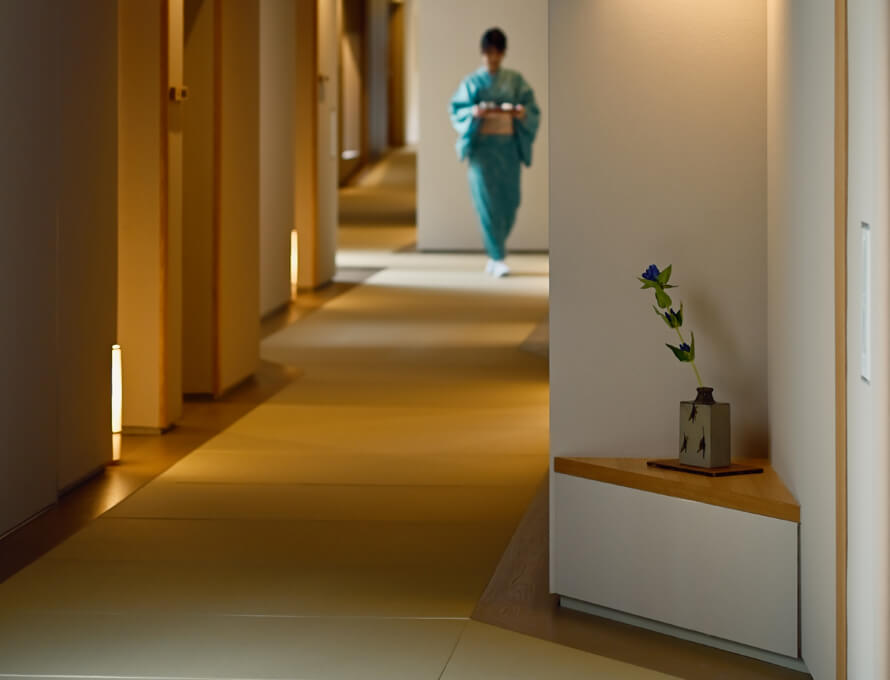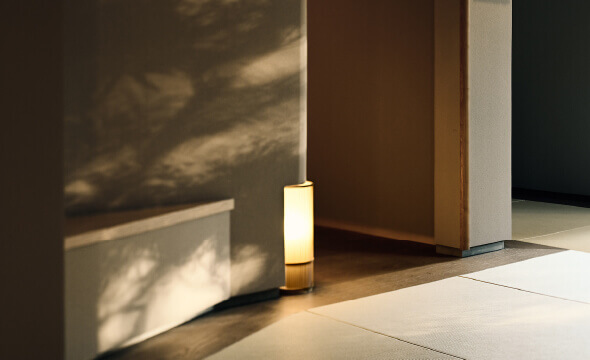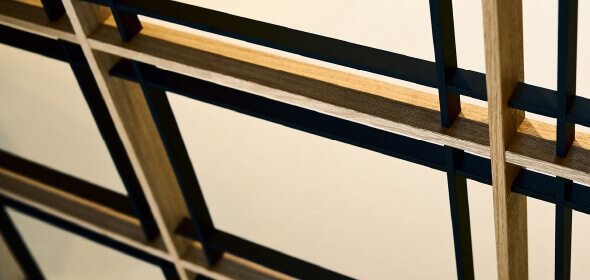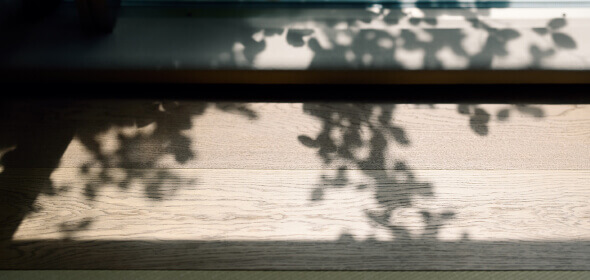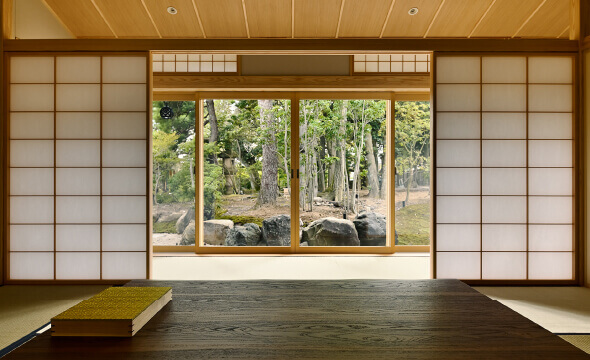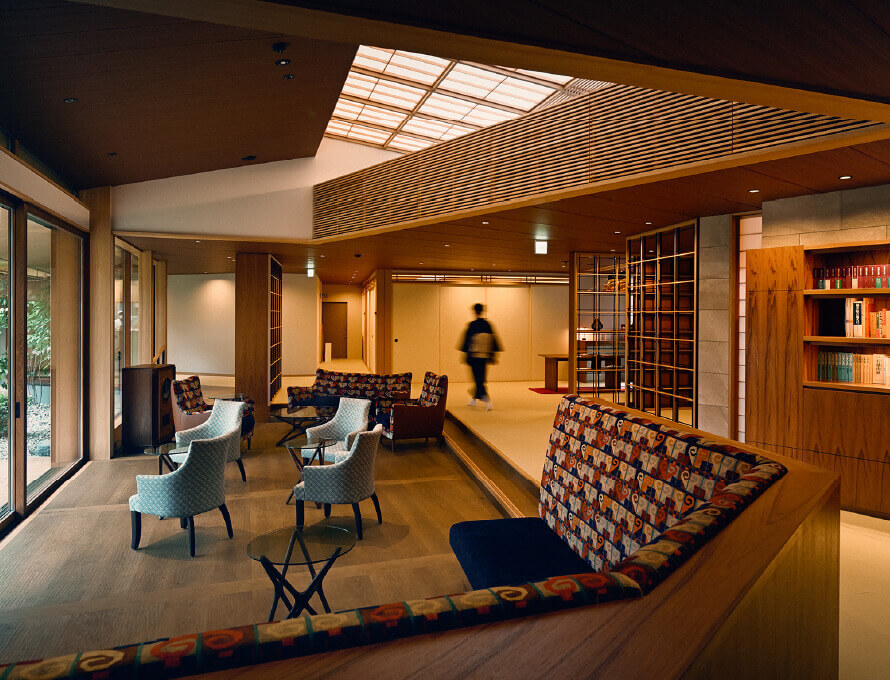べにや  BENIYA
BENIYA
Facility | 施設のご案内
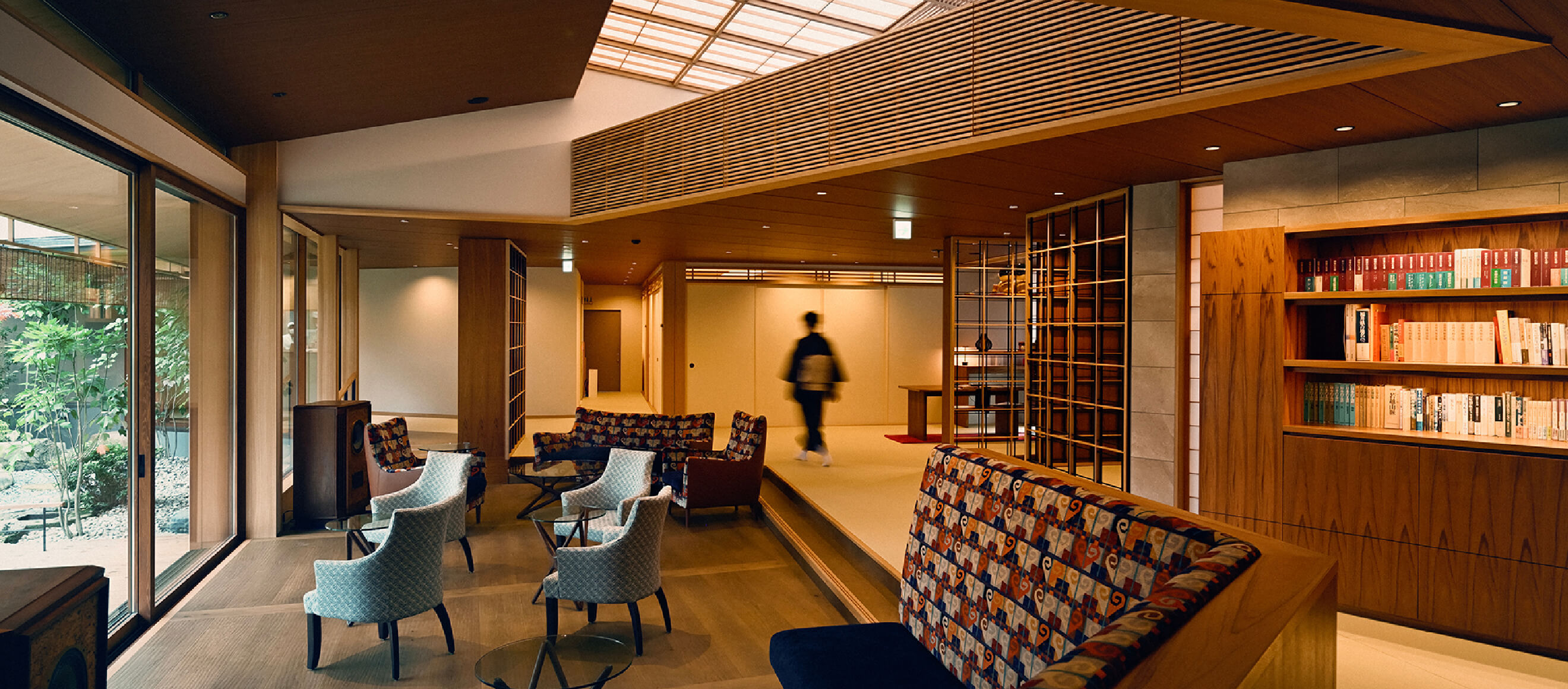
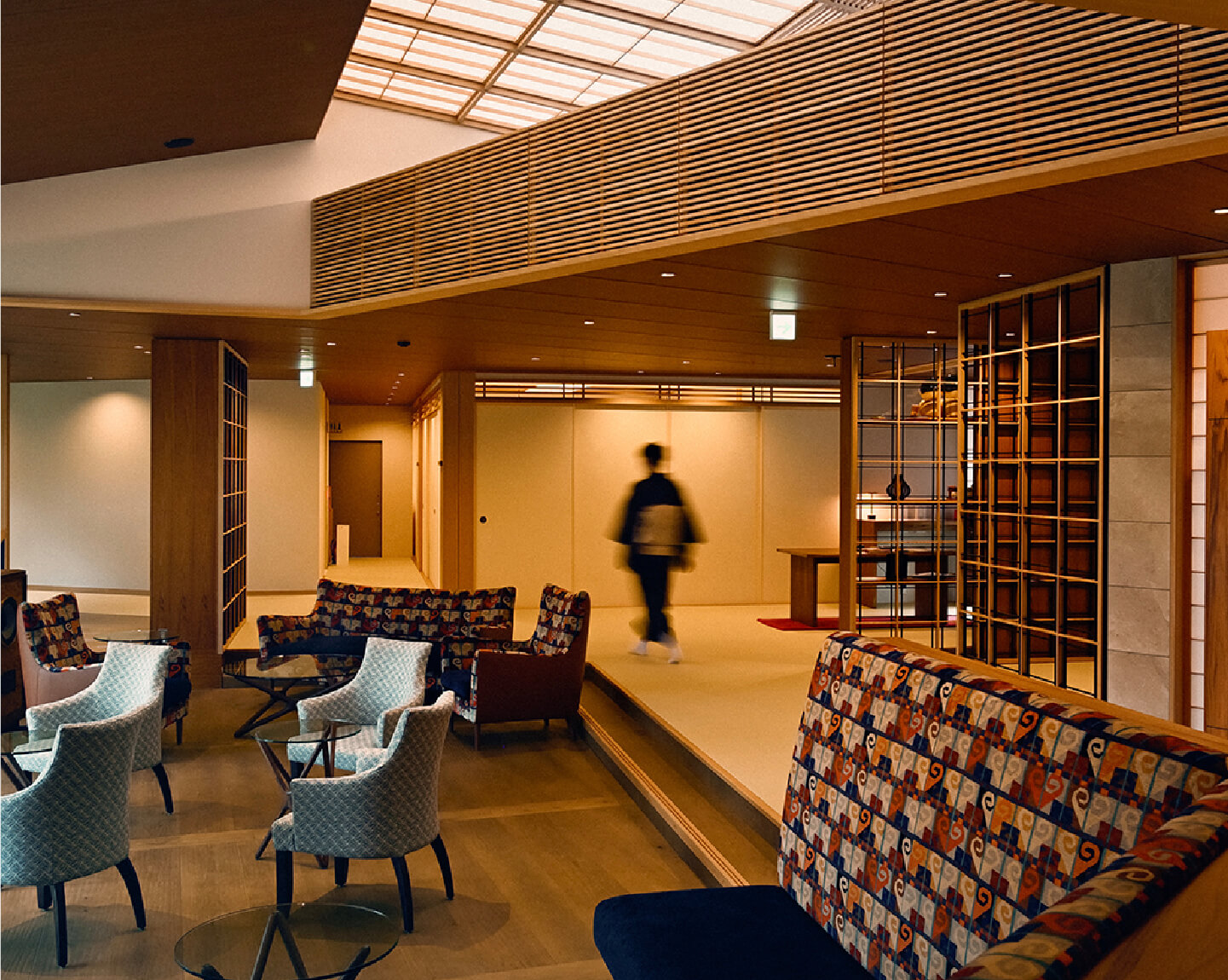
FACILITY
We welcome you with a new look for a new era
which is based on 140 years of history.
Beniya is designed to feel open and spacious so
you can relax and enjoy the peace while
watching the changes of the seasons.
which is based on 140 years of history.
Beniya is designed to feel open and spacious so
you can relax and enjoy the peace while
watching the changes of the seasons.
INSIDE THE INN
As well as the wonderful seasonal views from the lobby lounge, there are places here where an unexpected sight will make you want to stop and linger. These include wonderful examples of Japanese traditional art such as Echizen washi paper and Echizen tansu chests of drawers.
It is comfortable inside because the heat from the hot springs spreads throughout the whole inn. This means it remains warm even in winter.
Please enjoy the warmth in bare feet rather than slippers.
It is comfortable inside because the heat from the hot springs spreads throughout the whole inn. This means it remains warm even in winter.
Please enjoy the warmth in bare feet rather than slippers.
SOUVENIRS

Washi (Japanese paper) fabric boat-neck shirt
This original loungewear was designed for relaxing at Beniya.
Made by the sewing company Monster in Echizen City.
Designed by YODA in Dusseldorf, Germany.
Manufacturer: Monster Co., Ltd. [Echizen City]
Made by the sewing company Monster in Echizen City.
Designed by YODA in Dusseldorf, Germany.
Manufacturer: Monster Co., Ltd. [Echizen City]
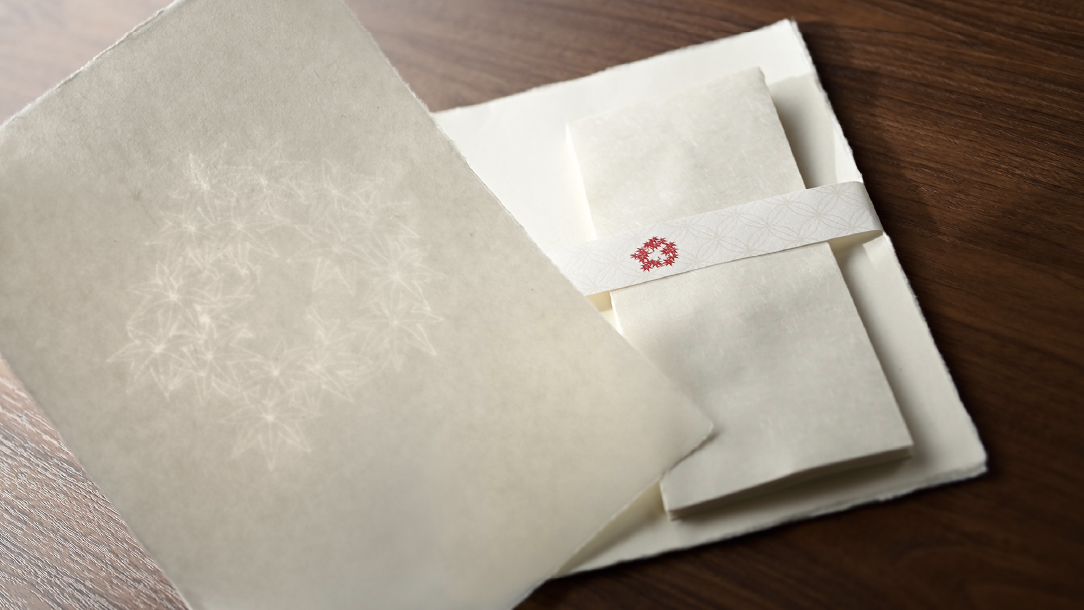
Beniya original handmade watermarked
Echizen Washi stationery envelope
Echizen Washi stationery envelope
This washi paper bears a momiji maple watermark which is Beniya’s original design.
Beniya and Yamagishi Washi collaborated to create this special stationery.
Each piece of washi paper is handmade.
Manufacturer: Yamagishi Washi Co., Ltd. [Echizen City]
Beniya and Yamagishi Washi collaborated to create this special stationery.
Each piece of washi paper is handmade.
Manufacturer: Yamagishi Washi Co., Ltd. [Echizen City]

Good-luck coasters and
building blocks
building blocks
These coasters and building blocks are carefully made by the craftsmen who carry on the traditions of making Fukui’s Echizen tansu chests of drawers.
The wooden coasters are made with auspicious patterns and the building blocks are carefully smoothed and invite you to touch them.
Manufacturer: Oyanagki Tansu [Echizen City]
The wooden coasters are made with auspicious patterns and the building blocks are carefully smoothed and invite you to touch them.
Manufacturer: Oyanagki Tansu [Echizen City]

Beniya original UKIGAMI
bunko box
bunko box
This original bunko box was made by a collaboration between Yamatugi Seishisho who makes a unique kind of Echizen washi paper called ‘UKIGAMI’ and Mr Yamaguchi Yuko who is a skilled craftsman of traditional Echizen tansu chests of drawers.
Manufacturer: Yamatsugi Seishisho [Echizen City] / Furnitureholic [Echizen City]
Manufacturer: Yamatsugi Seishisho [Echizen City] / Furnitureholic [Echizen City]

Accessories by KISSO
These accessories are made using cellulose acetate, which is commonly used for making frames for glasses. Cellulose acetate is a natural material derived from mainly cotton.
Manufacturer: KISSO Co., Ltd. [Sabae City]
Manufacturer: KISSO Co., Ltd. [Sabae City]
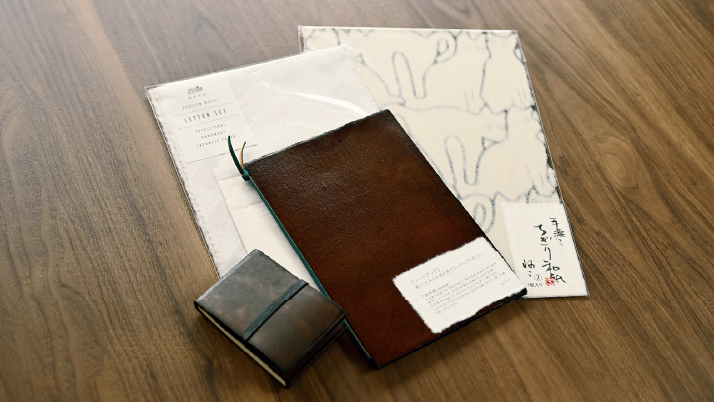
Stationery
Sugihara Washipaper pushes the boundaries of washi paper-making. Beniya’s Okami (female manager) carefully chooses the most interesting products from their range, including the type of paper coated with Echizen lacquer called “ul washi”.
Manufacturer: Sugihara Washipaper, Inc. [Echizen City]
Manufacturer: Sugihara Washipaper, Inc. [Echizen City]

Sake “Okami”
Beniya’s Okami, a qualified sake taster, commissioned the production of this Junmai Ginjo Nama Chozo sake “Okami.” She was involved in every step of the process from planting the rice to brewing the sake.
Manufacturer: Kubota Brewery Ltd. [Sakai City]
Manufacturer: Kubota Brewery Ltd. [Sakai City]

Eral PREMIER
The manufacturers carefully studied aging mechanisms before making these shampoos and conditioners. They are designed to enhance your natural beauty and to maintain the luster of your hair.
Manufacturer: Nicca Chemical Co., Ltd [Fukui City] / Eral Co., Ltd. [Minato-ku, Tokyo]
Manufacturer: Nicca Chemical Co., Ltd [Fukui City] / Eral Co., Ltd. [Minato-ku, Tokyo]
The Architect of Beniya

Light, Wind and Earth.
Taking advantage of the calm nature,
we can be close to people and think
about them.
In such a Japanese inn.
Taking advantage of the calm nature,
we can be close to people and think
about them.
In such a Japanese inn.
My feelings toward Beniya Ryokan
I remember the first time I visited Beniya. It was a labyrinth of light. A long, dimly-lit corridor bent in a chevron shape with no end in sight. An endless stretch of eaves seen from the lobby. I instantly felt that I understood what makes traditional ryokans so attractive. There was an irrational sense of architecture as a collective body that has accumulated layers of time, and that had been organically expanded on an ad-hoc basis, which I had never felt in a newly-constructed building. I realized that the essence of ryokan is spaces that allow you to feel the changes of the times.Time and climate have created a welcoming and comfortable place
It must be the connections and overlapping of many thoughts and feelings that create the place known as a ryokan. The place feels as if something more is there. Perhaps the building conveys the sense of the passing of time. The comfort of Beniya arises from the feeling of being protected by the climate of Awara, the long history of the building and the connections between all the people who have passed through its doors. I think that Beniya Ryokan will continue to be the embodiment of irrationality.The building that connects and grows
Beniya continues to grow as a place where relationships between people are built, thoughts are linked and gentle connections are valued. As a person involved in the construction of new buildings, what I have aimed for is an architecture that can grow into the future, with a structure that can be expanded and renovated.Never leave, stay neither too close nor too far
The new Beniya has 17 rooms, all with different designs. This is not much for a ryokan, but there are still plenty of places where you can find a small but comfortable retreat. You can be alone if you wish, but not necessarily lonely. I designed the building so the staff can care for the guests with the spirit of “Never leave, stay neither too close nor too far”.Natural light and gentle breezes
Based on the structure where each guest room is semi-detached, natural light can reach all the guest rooms, even the bathrooms. The corridor was designed so you can experience the world of light and darkness. A small tsuboniwa garden between the guest rooms allows the breeze from the Fukui Basin to flow through the inn. A tsuboniwa is like a universe. The presence of the tsuboniwa ties together all the design elements into a harmonious whole which then suggests further changes to layouts and finishes for all the rooms. The corridor design, where it is subtly angled so the end cannot be seen, reflects the experience I had when I first visited Beniya.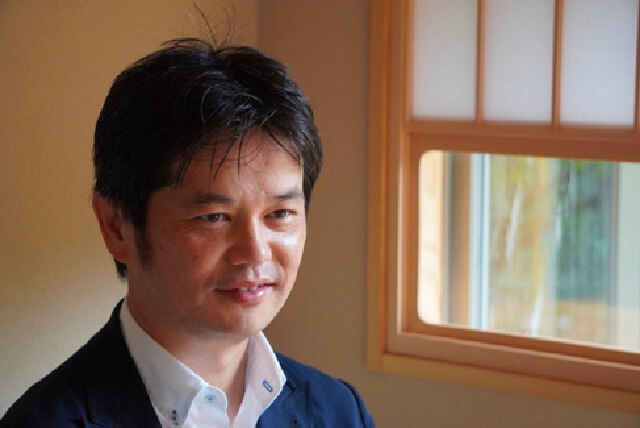
Tetsuo Kobori Architects
Representative: Mr. Tetsuo Kobori
Representative: Mr. Tetsuo Kobori
Born 1971 in Gifu Prefecture, Japan.
Graduated with a master’s degree in Architectural Engineering, Graduate School of Engineering and Design, Hosei University (Jinnai Hidenobu Lab), and joined Kume Sekkei Co., Ltd.
Established Tetsuo Kobori Architects in 2008.
Appointed as a lecturer in 2014, and later as a professor in 2021 of the Faculty of Engineering and Design, Hosei University.
ROKI Global Innovation Center -ROGIC- (Hamamatsu, Shizuoka) designed in 2017 won the JIA Japan Institute of Architects Grand Prix, as well as the AIJ Architectural Institute of Japan Award, the highest award given to architects in Japan. It was a remarkable achievement in that he was the first person to receive both awards in the same year.
In 2019, for the second time he received the JIA Japan Institute of Architects Grand Prix for the NICCA Innovation Center of NICCA Chemical Co., Ltd.
He is the first architect to win the JIA Japan Institute of Architects Grand Prix twice.
Graduated with a master’s degree in Architectural Engineering, Graduate School of Engineering and Design, Hosei University (Jinnai Hidenobu Lab), and joined Kume Sekkei Co., Ltd.
Established Tetsuo Kobori Architects in 2008.
Appointed as a lecturer in 2014, and later as a professor in 2021 of the Faculty of Engineering and Design, Hosei University.
ROKI Global Innovation Center -ROGIC- (Hamamatsu, Shizuoka) designed in 2017 won the JIA Japan Institute of Architects Grand Prix, as well as the AIJ Architectural Institute of Japan Award, the highest award given to architects in Japan. It was a remarkable achievement in that he was the first person to receive both awards in the same year.
In 2019, for the second time he received the JIA Japan Institute of Architects Grand Prix for the NICCA Innovation Center of NICCA Chemical Co., Ltd.
He is the first architect to win the JIA Japan Institute of Architects Grand Prix twice.




